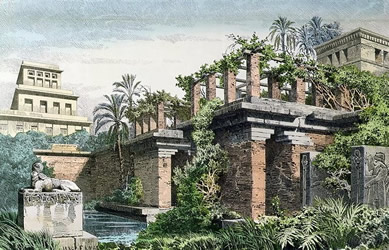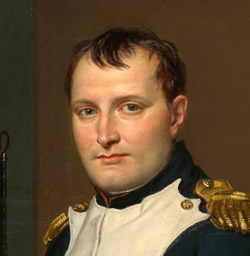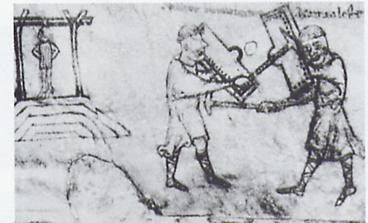
This is a painting by Ferdinand Knab of the Hanging Garden of Babylon.
By Ferdinand Knab (1834-1902) [Public domain], via Wikimedia Commons

This is a painting by Ferdinand Knab of the Hanging Garden of Babylon.
By Ferdinand Knab (1834-1902) [Public domain], via Wikimedia Commons
Ancient Babylon: King Hammurabi ruled Babylon from 1792-1750 BCE. He had a stone engraved with a code of laws called the Code of Hammurabi. It was placed in the town where all people could see and know the laws. The punishments were very harsh and were to be given out by the state, not by individuals. The state can intervene to resolve disputes.

This is a painting by Raphael entitled “School of Athens”.
Source: Raphael [Public domain], via Wikimedia Commons
Ancient Greece: In Greece we see the emergence of concepts such as democracy, trial by jury and the principle of impartiality that are fundamental concepts in our current system. The laws in Greece were also displayed in public so that the people could know that the laws applied to all people equally.

This is an image of a tile mosaic of Emperor Justinian.
Source: By Meister von San Vitale in Ravenna [Public domain], via Wikimedia Commons
Ancient Rome: The civilization of Ancient Rome was a major world power from roughly 500 BCE to 500CE. They developed laws to govern contracts, property, marital and parental responsibilities. In 529 CE Emperor Justinian codified ( This means arrange laws or rules into a systematic code.) Roman law. This code of laws applied to all people. Justinian’s Code is sometimes called the Corpus Juris Civilis ("Body of Civil Law" is the modern name for a collection of fundamental works in jurisprudence, issued from 529 to 534 by order of Justinian I, Eastern Roman Emperor.).

This is an image of a group of Eastern White Pine trees.
Source: By US FWS [Public domain], via Wikimedia Commons
Gayanashogowa or Great Binding Law: When Europeans arrived in North America they discovered a flourishing civilization that had complex economic, legal and political systems. The First Peoples of North America cherished and educated their children, recorded and transferred their history to younger generations. They also had methods to resolve conflict. The primary example was the creation of the Haudenosaunee Confederacy. In approximately 1450, the Mohawk, Onondaga, Seneca, Oneida and Cayuga (and later the Tuscarora in 1714) crafted the Great Binding Law.The Iroquois' Great Binding Law, sometimes called the Great Law of Peace, was recorded on a wampum belt (This refers to small cylindrical beads made with shells, strung together and worn as a decorative belt, used as money or arranged in patterns to convey the meaning of treaties or agreements.) and is symbolized by the Eastern White Pine tree. “It is considered the first known constitution in North America. It was not a written document, but a very detailed oral tradition that stipulated the structure, governing rules and principles of the Confederacy.”
Source: Meredith Moore and Ashley Moran. “ American Roots”,

This is an image of a painting of Napoleon Bonaparte.
Source: Jacques-Louis David [Public domain], via Wikimedia Commons
France: In 1804 Napoleon Bonaparte of France introduced the civil law system which forms the basis of the legal system in Quebec. When the British defeated the French in 1759 the French retained this legal system through the Quebec Act of 1774.

This is a drawing that represents a trial by combat.
Source